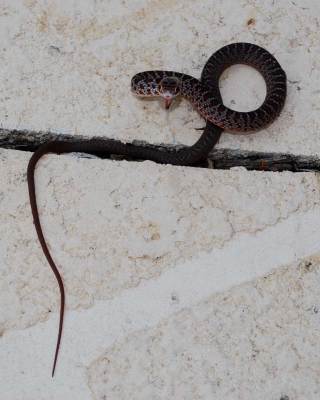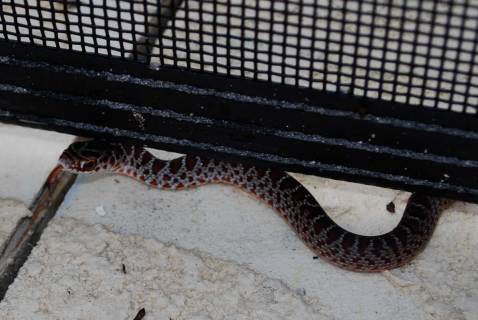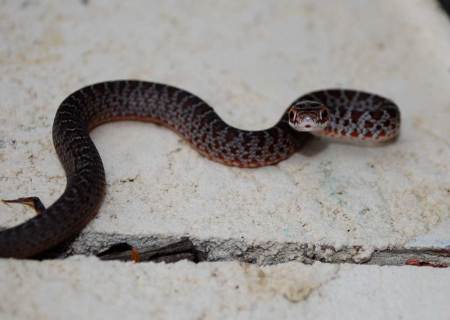Eric and I were swimming one evening when I noticed a small stick floating in the corner of the pool. Upon closer inspection, it was no stick, but an elongate limbless vertebrate in the group Serpentes (i.e., a snake!). Remember, all snakes can swim. And it was having a fine time in its little corner of the pool, but it seemed like a good idea to get it out, just so Eric wouldn’t wander over there and either get too excited or too scared.
I don’t have much experience with snakes, but I’m pretty sure it was a baby snake, not just one of the small species, for several reasons.
First, the body length is only about 12 inches. As you can see in the full-body shot below, it fits easily into the deck drainage crack, which is only about 1/8 inch wide:
Second, as you can see from that picture, the tail is very long and skinny; no rattles, either. (Woo-hoo! We just ruled out 3 of the 30 or so Florida snake species!) To me, that means this snake hasn’t finished growing. Of course, I could easily be wrong here.
Third, in its threat displays, it tried very hard to bite me, despite having teeth too small to do any damage, and it never managed to get me, but it did put a healthy fear into me.
And fourth, I can’t find a picture of anything like this snake in my guides, and it’s well known that baby snakes often have vastly different markings from the adults.
Going through the identification steps suggested on one helpful website, we can classify this snake as having:
- “typical” body shape (on the range slender—typical—stout)
- “medium” head size (on the range “no neck”—medium—broad headed)
- blotched markings
- round pupils (therefore not a pit viper)
Unfortunately, there are quite a few typically shaped, medium-headed, blotched snakes with round pupils in Florida and the southeast, making identification quite a bit more difficult for the non-herpetologist like me. Despite the vague descriptions above, which might be incorrect, I have no idea what kind of snake this is; do you?
Here are a few more pictures:
The pool fence you see in the background looks inordinately large; to give you a sense of scale, the black trim on the bottom is a whopping one inch high, and the portion of the snake on top of the “grout line” in the deck surface is about 3 inches long.
This little guy did not show much gratitude for me “saving” it from the swimming pool (yes, I know snakes can swim and they can climb things that you wouldn’t think they can, but still…). Once it was on the deck, it wasted no time trying to strike at me. Here’s a head shot, showing its fierce disposition:
It’s a good thing I knew enough about snakes to know that this was not a venomous snake, but that didn’t stop me from being a little weirded out anyway. Something about snakes evokes some primal sense of unease, dating back to our distant ancestral past, I’m sure (almost all apes apparently react strongly to snake and snake-like objects). In fact, modern snake genera differentiated from the rest of the serpents over 20 million years ago; on the other hand, we hominins branched off from our common ancestor in the primate group less than 5 million years ago. So we’re probably pretty hard-wired to avoid snakes when we can.
Even dogs have this same response; expose a dog to a snake for the first time in its life, and it “knows” not to attack.
Even though fewer than 20% of advanced* snake species worldwide (and only 16% in Florida) can defend themselves with venom, it’s just not worth the risk to take on a bluffing threat display from an elongate limbless vertebrate.
All in all, I was just glad to get this aggressive little guy out of the pool and still have time to run inside and grab my camera, so maybe someone who knows more than I do can help me figure out what the heck it is.
*Biologists classify snakes into three groups: blindsnakes (300 species worldwide), two different basal groups (160 species between them worldwide), and the Colubridae, often called advanced snakes (all the rest). The basal snakes include the charismatic megafauna among Serpentes: pipesnakes, boas, pythons. One noted researcher characterizes their outsize appeal in these terms:
I can probably recall every individual basal snake among thousands of other serpents I’ve seen in the field.
This group’s popularity has of course led to some problems; here in the Everglades we have a potentially explosive population of Burmese Pythons (Python molurus bivittatus) to deal with. The advanced snakes, the Colubridae, make up about 80% of the world’s snakes, so I’m sure there’s going to be some taxonomic shuffling soon; no grouping of nearly 2000 species is safe from splitting.
References
Ashton, R. E. (1988). Handbook of reptiles and amphibians of Florida, part 1: the snakes. 2nd ed. Miami: Windward.
Gibbons, W. (2005). Snakes of the southeast. Athens: U of Georgia P.
Greene, H.W. (2000). Snakes: the evolution of mystery in nature. Berkeley: U of California P.




Hello there! I was on a Varmint hunt in Central Montana when i had an intruder in my boot… and it was a snake. I too did not recognise it so i put it in my lunch pail and made it my pet. The snake i have ” now in my family room” is the EXACT same as in the pics above. What kind is it??? have you found out? Please let me know!
You know, I still haven’t gotten an ID on this thing. One thing I know for sure about baby snakes, though, is that not only do they not always (or even often!) look like the adults in terms of color and markings, they tend to look a lot like other species! I hope you (or I) eventually do find out what it might be!
Yellow bellied racer
Yellow bellied racer juvenile
Baby black racer is the snake. When young they look like and copy a rattle snake to help their survival in the wild.
Thanks, J.
Yes, once I saw an adult black racer in the yard I looked harder at my guide books, and, as you can see here, about two weeks ago, I ID’ed it as a baby black racer.
That is a baby black racer for sure.
, I don’t know where you get a black racer from? Not a bit of black on it.
I’ve been and lived around snakes all my life here in the fla, Everglades and Steve has it! Rat snake. My girlfriend has a huge 7′ one hanging around in her yard all the time. That’s usually the max they will grow! But they are beautiful!
Maybe try googling baby black racer and you will then see you are VERY WRONG! I am a native Floridian, and have lived her for over 40 years, and this most certainly IS A BABY RACER! If you would have taken the time and read the whole fascinating article he took the time to do for us you would have known that a black racer as a baby has few defenses, one Major one is the ability to camouflage itself with the very different scales as an adult racer which is all black but an off white yellowish belly. The baby looks like a baby rattler bc it doesn’t have yet the same abilities as mom and has NO VISUAL SIMILARITIES OF MOM! So I hope that answers your question why he came to the conclusion maybe you would have known this had you read the whole article start to finish instead of bombarding into his comment section trying to tell a man who obviously knows his stuff about his stuff! Do better. Read more
I have just captured one of these exact baby snakes in my Florida Lake Side house …. I am a native Floridian and I was an avid Snake Hunter when I was just a kid … my Instinct tells me that it is a baby RAT SNAKE … it has the FLAT BROAD BELLY SCALES FOR CLIMBING its too young to see if it will be a RED or YELLOW RAT but from the MARKINGS I am guessing a RED RAT / also known as a Corn Snake …that would be my guess – the Markings look ominous pattern wise – looks alot like a Water Moccasin but the HEAD is not the same – as you mentioned ( No Diamond Shape no Cat Eyes no Pits = No Threatening identifier ) BUT in the state of FLORIDA you can’t assume anything as there are TONS of Exotic Snakes that have escaped and or turned loose in the Florida Habitat and they can multiply – so YES you could SEE A COBRA in your back Yard ( no it is not indigenous, but that does not remove the possibility of an escape’ee or descendent of an escaped serpent ( but I stick to my guns on this one ….. BABY RAT SNAKE ….
My neighbor just had one removed like this and with all the “interneting” for its identifying we decided that it was a juvenile & either a eastern milksnake vs corn snake variety.
As I was trimming grass along side walk, I disturbed a sm. squiggly blk snakew/orange top head to tail, he came from the soil, then disappeared as I turned my back, I noticed in my screen room a baby slitherd on a glue trap I had placed. Very thin, about 5 ” long, I am petrified of any snake, can you help identify, I would appreciate it, this little snake slipped right under my screen door. HELP, please, the glue trap was intended for palmetto bugs, thank you,
If he looked like the one in the pic it’s a juvenile eastern yellow bellied racer which are are nonvenoumous and harmless. All snakes are great especially for your palmetti bugs as the young will eat them and mice and rats have no fear!
I found about 20 eggs under a rock while mowing the lawn .I placed them in a bucket of sand a week ago and today came home from work and found 6 live ones so far.As I’ve ruled out venomous they can go play in the jungle .I think baby black racer not hostile at all.
Just found one in our pool today~ a few guesses have been helpful, but I thought baby racers were grey with no stripes. So….anyone out there??? Help! I don’t trust most any snake out here in SW Florida! I do hope it’s a baby racer though! Those are the good ones~
Juvenile yellow bellied racer no worries
It’s a juvenile black racer. They don’t get darker until they get older. But based upon your pictures in my humble opinion it would be a juvenile black racer. Nonpoisonous snakes tend to have round large eyes whereas poisonous snakes would have more oval eyes
My daughter and I found this critter. As long as they do not pose any threats, they are free to go
Just before cold weather started in Ga my husband and I were working on securing our water pipes from the cold, when I noticed behind me on the ground a very small or baby snake . He was yellowish color with a copperish brown spot on his head he was not aggressive at all.
I have spoken to several people who say it was probably not a baby copperhead.
That’s a baby black racer! Just looked it up because my boyfriend and I found one as well thinking it was a baby rat snake. A little disappointing that he’s a racer but it was a mission trying to figure out what this little guy was with his faded tail. Thanks this was helpful!
We had a similar snake on our back patio. It coiled up and shook it’s tail, but it didn’t have a rattle. It was a little over a foot long.
From the information here and elsewhere I think it was a juvenile black racer.
Tampa Bay Florida
Same here. Shook tail on patio. Have found a couple other black racers around so figure that’s what it is.